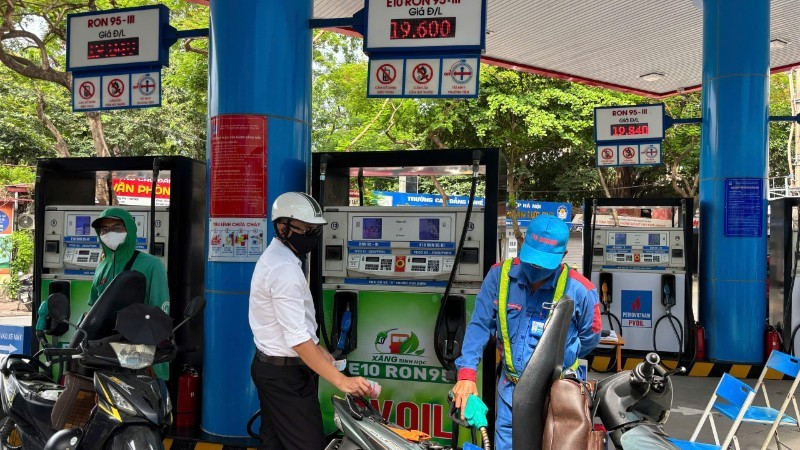Coherent policies needed for biofuel adoption
Biofuel E10 RON95-III has been piloted for sale in Ha Noi, Ho Chi Minh City and Hai Phong from August 1, in an effort to promote environmentally friendly fuels and make use of domestic production. For biofuels to gain widespread acceptance among consumers, coherent policies are urgently needed, covering production, distribution and consumption.

Biofuel safe for engines
In the initial days of the E10 RON95-III pilot, the Viet Nam National Petroleum Group (Petrolimex) and Viet Nam Oil Corporation (PVOIL) offered the fuel at 42 stations—36 in Ho Chi Minh City, four in Ha Noi and two in Hai Phong. Each litre of biofuel was priced at 19,600 VND (0.79 USD), the same as RON92 and 240 VND (0.01 USD) cheaper than RON95.
At a petrol station on Thai Thinh Street (Ha Noi), buyers of E5 RON92 and RON95 far outnumbered those opting for E10 RON95-III. Some residents said they were aware of ethanol-blended petrol but remained concerned about its safety, performance, engine compatibility and potential fire risks.
On the first day of trial sales, each station sold around 1,000 litres of E10 RON95-III. Most consumers remained cautious, with many saying they did not understand what E10 RON95-III was or how it differed from RON95.
According to the Ministry of Industry and Trade’s Biofuel Handbook, biofuel is a blend of traditional petrol (RON) and ethanol, with the letter “E” indicating the ethanol ratio. For instance, E10 RON95-III contains 10% bioethanol and 90% conventional RON95. Adding ethanol replaces certain oxygen-containing compounds previously used, such as lead and ether.
The Ministry states that numerous studies and trials by domestic and international scientists and experts have shown that with ethanol content at 10% or below, biofuel does not affect the engines of most vehicles currently in use.
Associate Professor Dr Pham Huu Tuyen, Director of the Centre for Research on Engines and Autonomous Vehicles at Ha Noi University of Science and Technology, affirmed that E10 RON95-III is technically equivalent to conventional RON95. His centre has conducted extensive research on biofuels such as E5 and E10 on representative models of cars and motorbikes.
Test results showed that engines running on E10 RON95-III delivered similar power and fuel consumption to those using RON95. Moreover, harmful emissions such as CO and HC decreased by an average of 20–30%, contributing to improved air quality. As ethanol is bio-based and renewable, the fuel helps reduce dependence on fossil resources and lowers CO2 emissions.
E10 RON95-III is technically equivalent to conventional RON95. The Centre for Research on Engines and Autonomous Vehicles has conducted extensive research on biofuels such as E5 and E10 on representative models of cars and motorbikes.
Associate Professor Dr Pham Huu Tuyen, Director of the Centre for Research on Engines and Autonomous Vehicles at Ha Noi University of Science and Technology
From his findings, Associate Professor Dr Tuyen confirmed that most cars and motorbikes in Viet Nam can safely use E10 RON95-III without any technical modifications. Vehicles do not need to empty their tanks before switching fuels, as E10 can be mixed with conventional petrol. Currently, vehicle manuals in the Vietnamese market specify that engines are compatible with ethanol blends of up to 10%.
However, for vehicles more than 25 years old, users are advised to consult authorised service centres before switching, as some older models may contain materials incompatible with ethanol, such as fuel pipes, rubber gaskets or metal fuel tanks. In such cases, adjustments and component replacements may be necessary.
Policies needed to encourage consumption
Experts stress that E10 biofuel is not a new concept. Many countries have used E10 with various RON ratings (from RON92 to RON95) for decades.
In the US, ethanol blends of up to 10% have been widely used since the 1970s for all types of vehicles. Higher blends such as E15, E20 and even E85 for flexible-fuel vehicles have since been developed.
Brazil is a pioneer in biofuels and no longer uses E5 or E10; E27 is standard, while some vehicles run entirely on ethanol (E100). In Thailand, E10 accounts for 70–80% of the retail petrol market. Long-term use worldwide demonstrates that E10 is safe.
According to the Government’s roadmap, Viet Nam plans to roll out nationwide sales of this green fuel from January 1, 2026. With abundant agricultural resources such as cassava, maize and agricultural by-products, the country has strong potential to develop ethanol production.
The Ministry of Industry and Trade reports that Viet Nam currently has six ethanol plants with a total annual capacity of about 500,000 cubic metres.
Experts argue that to boost biofuel adoption, a comprehensive set of measures is required. The State should issue policies to unlock market potential. Initial measures could include tax incentives, input subsidies for ethanol, or guaranteed purchasing at stable prices to build producer confidence. At the same time, public communication must be strengthened to ensure people fully understand E10 RON95-III.
Ethanol producers also need support in financing, technology and feedstock planning to ensure stable and diversified supply. At present, most domestic ethanol comes from cassava, which has limited reserves and relatively low efficiency, making production costs high and reducing competitiveness against fossil fuels.
Fuel distributors should also receive incentives to expand retail networks. The earlier roll-out of E5 RON92 showed that many stations discontinued sales due to low demand and unprofitable volumes. Consumers have suggested that stronger government incentives are needed to drive uptake. With current prices only a few hundred dong per litre lower than fossil petrol, biofuel remains insufficiently attractive to influence consumer behaviour.
Associate Professor Dr Nguyen The Luong of Ha Noi University of Science and Technology noted that while developing biofuels is an encouraging step, it should not be seen as the only solution for reducing transport emissions. Globally, attention is shifting towards next-generation fuels such as algae-based ethanol, hydrogen, biogas and hybrid vehicles. Hydrogen fuel, in particular, is being trialled in many countries for large-scale transport modes such as trains, buses, heavy trucks and ships.








